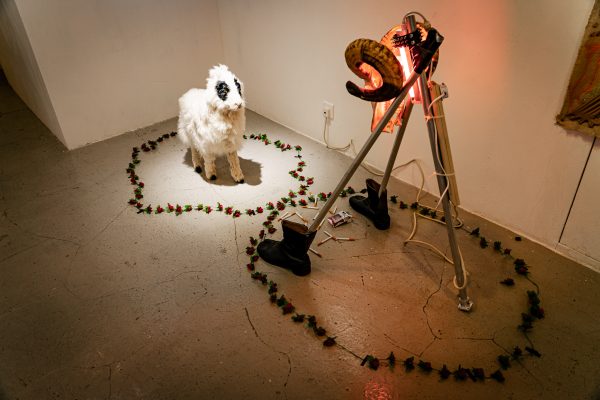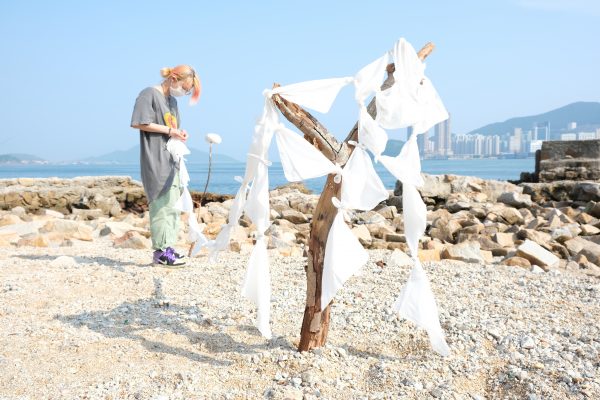Martha Hatch detected a shift within the art scene in some shows she visited late last year. A new form of resistance? A new way to stay alive? An attempt to preserve a Hong Kong spirit? Hatch in in her final semester researching on art and urban space for her BA graduation thesis.
*This essay was originally published on the AICAHK website on 21st December 2020.
**Feature image courtesy of landescape1823
During and after Hong Kong’s 2019 anti-government social and political protests, “Hong Kong is Dead” has been one of the most frequently heard phrases of the last two years. Hong Kong was continually and ‘officially’ pronounced dead by protesters each time the government breached what is commonly perceived as Hong Kong’s core values. This death seems to have echoed in the unprecedented silence (of protesters) after the enacting of the National Security Bill in mid-2020.

In parallel to this muffled sound/landscape, other voices of resilience, in the art scene at least, appear emerging. I immediately noticed “DM@576gallery for reservation” in a post circulating amongst the digital-savvy art crowd on Instagram (in internet terminology, ‘DM’ and ‘PM’ refer to messaging privately). The post showed an invitation with what appears to be a white cube stained with black ink, with a circular array of words, the exhibition title: “While I know how fragile young talent is, I’d love to hear the particulars of how your dreams were squashed.”.
I arrived at the gallery at exactly 9pm. As I entered the room, I was greeted with puzzled gazes. I felt out of place amongst this group of ‘alternative looking’ young people. This sense of difference and almost-hostility was intensified by the murky child-like works that dangled around the space. The artwork had qualities of distorted juvenility, with a few of the artists using materials that reminded of ‘toys.’ Ranging from a corpse-like Hello Kitty stuffed toy (Bye Pussy by Kwan); a toy crane hanging a CT-scan of the artist’s tumour (。。。ɮɨɮɨ, 。。。฿Ʉ฿Ʉ 喂呀喂呀喂呀>< XDDDD by Jennnital ); and, a psychedelic voodoo-looking doll (Spica by Mia Chu). Aside from these ghoulish works, the space’s walls were scribbled with writings in pencil, some giving the audience a glimpse into the artists’ thoughts while other text appeared to be gibberish. At the height of the opening, one of the participating artists, B.maus, set-up a ladder, climbed up and towered over the surrounding crowd. Suddenly, she threw a DJ turntable set from the ladder with tremendous force, crushing it upon landing. Her anger and the performance’s energy rippled through the crowd and was a commentary on the current Hong Kong trend of too many exhibition openings being transformed into a ‘party venue.’ Aside from the materiality of the works that challenged the conventional aesthetics of ‘contemporary art’, the very use of the space is perhaps this show’s strongest statement. The exhibition was held with semi-permission, within the short transition period when the previous gallery had moved out and just before the keys were to be returned to the landlord, without the acknowledgement of either side. This explains the secretive nature of the exhibition.


Landescape1823 is another collective who roam around abandoned locations and create site-specific work from materials gathered onsite. The art group resembles Anarchitecture, a critical artist group who appropriate the unwanted and unclaimed parts of the city. Landscape1823 has hijacked ‘rotten’ spaces and reinjected a new form of energy. In one of the editions, located in Ma Wan, rather than being annoyed at these young artists invading their land, the remaining older villagers seemed rather amused and excited by these new works. Landescape1823 attempts to reclaim this abandoned Ma Wan location through re-telling of the imagined history from the materials gathered onsite. These included piles of Japanese pornography, bike wheels, furniture etc.


[images of works provided courtesy of landescape1823]
However, the example of 576 Gallery and landescape1823 using ‘guerilla’ tactics, non-traditional spatial usage and aesthetics is only part of a recent shift in the Hong Kong art scene. The use of ‘raw’ materials in combination of using unusual locations or venue usage can also be seen in the exhibition “Afair”, in a Nathan Road shop-for-rent hosted by more mainstream artists.
Such transformation perhaps can be explained through the lens of micropolitics and a shift away from loud commentaries (e.g. protests) which were previously safe, but now to the adoption of smaller, yet fundamental, resistance. One of the crucial forms of micropolitics visible in this shift is the reproduction and use of space. According to Henri Lefebvre, a philosopher particularly influenced by the Situationists, a European anti-authoritarian movement active between the late 1950s to early 1970s, who argued that space is inherently political. Space is not simply a place in which to sit or live in, but how “power” asserts its authority on people by preconditioning ways of perceiving and conceiving space.

Take a white cube gallery, for example, Why is it that we would automatically restrain ourselves from touching a painting once it is hung on a wall in such a white cube gallery? Salvaging a space that symbolizes power through the means of unauthorized usage or repurposing the usage of space are forms of resistance through the reproduction of space, or even – conceivably – the reproduction of everyday life by changing the way we interact with these spaces in our daily lives.
These recent exhibitions perhaps indicate a shift within the art scene, maybe ushering a new form of resistance, and adapting and preserving the Hong Kong spirit during these times of government restraints on public political expression and Covid-19 social restrictions. Considering these recent alternative forms of resistance – albeit modest – Hong Kong is far beyond death, rather, it is very much alive.




